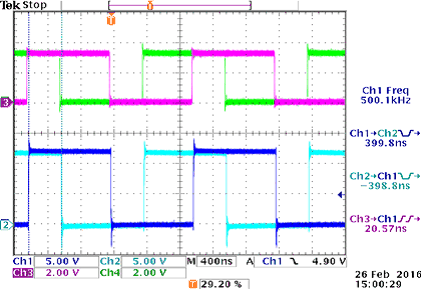SLUUBG8C November 2018 – October 2021 UCC20520 , UCC21320-Q1 , UCC21520 , UCC21520-Q1 , UCC21521 , UCC21530
7.1 DT Connected to VCCI (J-DT Option B in Table 3-2)
The dead time (DT) between the outputs of the two channels is decided by inputs (see Figure 7-1). Overlap between two output channels is allowed. Figure 7-1 shows a waveform with overlapped operations.
 Figure 7-1 Overlap is Allowed When DT Connected to VCCI (Channels 3 and 4 are PWM Inputs, Channels 1 and 2 are Driver Outputs)
Figure 7-1 Overlap is Allowed When DT Connected to VCCI (Channels 3 and 4 are PWM Inputs, Channels 1 and 2 are Driver Outputs)